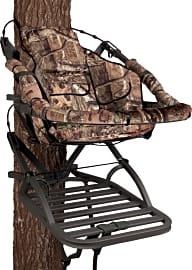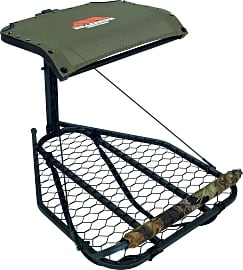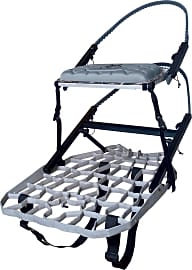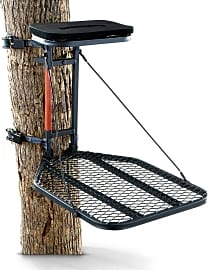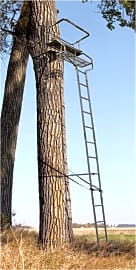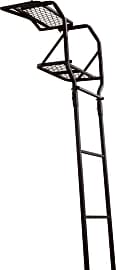The 10 Best Tree Deer Stands

This wiki has been updated 39 times since it was first published in July of 2015. While these tree deer stands are built to help hunters position themselves for the perfect shot, they’re also suitable for wildlife or nature photographers trying to get up close and personal with their subjects. They come in a variety of sizes and designs, with features like shooting rails for lining up your gun or camera and safety harnesses to prevent any accidents. When users buy our independently chosen editorial recommendations, we may earn commissions to help fund the Wiki.
Editor's Notes
March 24, 2020:
The Guide Gear Swivel was no longer available, so we took it off the list. We also decided to move the Millennium M50 up a bit, noting that it provides exceptional strength and durability despite a lack of bulk or weight.
Added the Rivers Edge Big Foot, a single-person model that has a surprisingly wide platform, which is helpful for hunters who prefer to shoot from an upright position or stretch their legs from time to time during the day.
It’s worth pointing out that the Summit stands are widely considered very comfortable — something to think about if you’ll be spending long hours in the tree during multi-day trips. You may want to consider applying your own anti-rust coating to whichever model you choose to ensure it remains in good condition throughout the season.
Special Honors
Muddy Outdoors Odyssey XTL The Odyssey XTL can accommodate up to 350 pounds, with a tough, powder-coated finish that protects it from extended exposure to the elements. Its design prevents it from producing any of those irritating metal-on-metal sounds, and it features a convenient cup holder on one side. gomuddy.com
Out on a Limb TS1 For hunters seeking the freedom to comfortably shoot in just about any direction, this high-end stand is worth a look. It tilts forward and backward and rotates side to side, allowing users to set up in a variety of different positions. The metal platform offers plenty of traction. outonalimbmfg.com
Taking A Stand: Selecting An Ideal Tree Stand
Most hunters who use rifles will fire their long gun from a seated position, and thus almost any tree stand will be suitable for them.
A tree stand is one of the best ways a hunter can ensure he or she comes home having enjoyed a successful hunt. Tree stands are easy to set up and take down and create the ideal platform for taking aim and making the shot count.
Some tree stands come with built-in ladders included, while others require a bit of tree climbing (often using an included safety harness) prior to the installation and use of the stand. It will likely come as no surprise that the stands with ladders tend to cost more than the stands alone. However, it is also worth noting that deer tree stands are not generally very expensive.
The price difference between the more expensive options and the most affordable units is only around one hundred dollars, so you should choose your stand based not on cost but on function. In some cases, for example, a stand with a ladder may not be desirable. An absent ladder may discourage others from climbing up to your stand when you're not using it, and will create only minimal visible disruption to an area so as not to frighten wildlife.
The type of hunting you prefer will of course do much to inform which tree stand is right for you. Most hunters who use rifles will fire their long gun from a seated position, and thus almost any tree stand will be suitable for them. Deer hunters who use a bow and arrow, however, may prefer to conduct their archery while standing. This merits a stand with a larger platform on which the bow hunter can spread his or her feet. If you are a bow hunter, also look for a stand with a large rail around it. This rail can kelp you stabilize yourself as you draw the string and hold your arrow knocked and ready, and can reduce the chance of a fall after you let the arrow fly.
Unlike a hunting blind, which is ideally set up many days (or even weeks) before you will actually use it in order to give deer time to become accustomed to the its presence, tree stands can be set up and used at once. A hunter, wildlife researcher, or photographer perched in a tree stand without a ladder attached is well above a deer's usual line of sight; so long as he or she stays quiet, it is not uncommon to have a deer venture near shortly after the stand has been erected and mounted. Still, any hunter (or wildlife watching enthusiast) can always use a bit of help when in the field -- read on to learn about ways to help ensure your hunt is a success.
Other Accessories To Help The Hunt
The best way to get a clean shot at or photograph of a deer is to lure the animal as close to you as possible. This can be done in myriad ways, but two of the most common are to use a game feeder to ensure regular wildlife visits to a given area or to use a deer call to actively attract deer to your area.
Game feeders are usually mounted on tripods or hung from trees and, when loaded with the right variety of food -- many hunters and wildlife experts swear that corn kernels can't be beaten in this regard -- will regularly attract plenty of deer once the animals learn to trust the feeder.
This consists of a pair of rattlers that, when clicked and clacked together, recreate the sound of the antlers of two male deer who are locked in a test of strength and will.
Active deer calls use one of two approaches to lure in an animal. First, there is the deer rattling approach. This consists of a pair of rattlers that, when clicked and clacked together, recreate the sound of the antlers of two male deer who are locked in a test of strength and will. In the hands of an experienced deer rattler, these calls can lure in other bucks who wish to challenge the males as well as does who want to see which male might be worthy of being her next mate. The other type of deer call usually consists of a mouth blown device that looks rather like a large whistle but which produces various wheezes and grunts (often called challenge noises) that can entice both male and female deer as well.
Even for the shooter with a scope mounted on his or her rifle, a good pair of binoculars can help spot a potential target. Binoculars tend to have a wider field of view and are quicker and easier to focus than a scope. Their use also requires very little movement once they are raised, so they minimize the chance of scaring off an animal. And for the bow hunter or the wildlife watcher, binoculars are a must for spotting those faraway deer, as no rifle scope is even present.
One other item you might not need in all seasons but surely won't regret having when the temperature has dropped is the hand warmer. Whether you choose an electric unit charged up via USB cable or a classic hand warmer fueled by petroleum distillate, a toasty pair of hands can mean the difference between a bagged buck and an empty truck.
A Few Facts About American Deer
There are well over thirty million deer alive in the United States at any one time; this is a robust population figure made all the more impressive given that only a hundred years ago the number had plunged to as low as 500,000 animals alive in America.
The remaining deer consist largely of the blacktail and mule deer varieties.
Of the tens of millions of deer alive today, the vast majority are white tailed deer, which represent as much as 88 percent of the population. White tailed deer can be found in all 48 of the lower continental states (and in Mexico and Canada, as well). The remaining deer consist largely of the blacktail and mule deer varieties.
Deer's eyes can see only a few colors. They are red-green color blind (as are some humans), which means they cannot see shades of red, which appear the same as shades of green or orange in their view. Deer can differentiate between blue and green and might even see some shades of red as different than blue/green, but they cannot detect the longer wavelengths of the red colors with any clarity. They do, however have excellent night vision thanks to the many rods the deer's eye contains.
In the wild, most white tailed deer live for less than five years -- in captivity, their lifespan can triple this figure.



